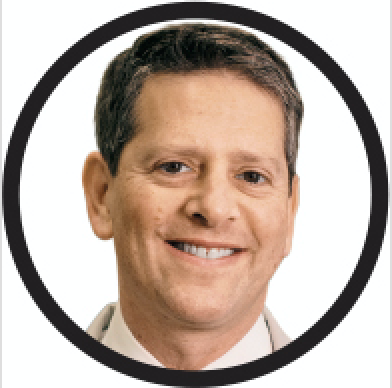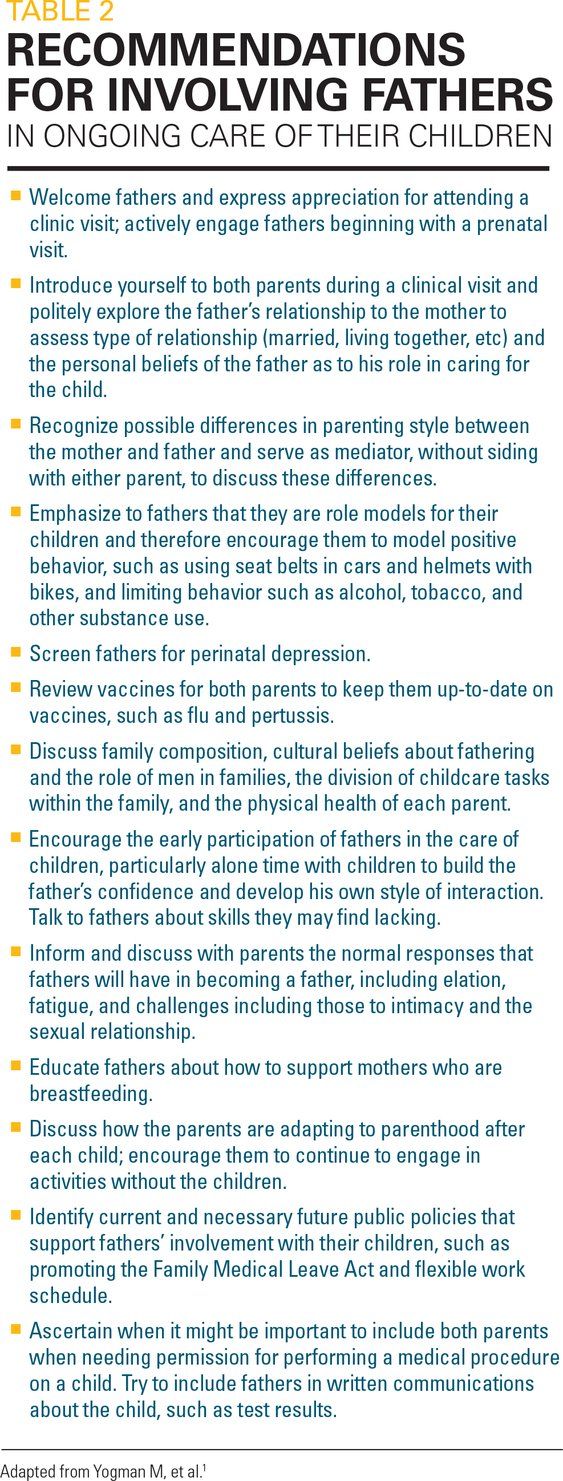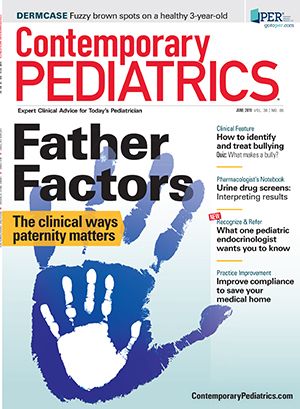Fathers’ influence on development and well-being of children
Despite the growing involvement of fathers in their children’s lives, there persists a lack of focus on fathers in pediatric care. Updated guidelines can help pediatricians to better engage fathers in the care of their children.
Craig F Garfield, MD

Table 1

Table 2

Growing evidence shows the positive influence that fathers have on the development and well-being of their children. Longitudinal data published over the past decade or so support that paternal involvement from the prenatal stage through a child’s lifetime benefits the psychosocial and behavioral development of their children, often in ways different from and complementary to maternal involvement.1,2 Other data exploring the biological and epigenetic influences of fathers on their children are revealing the complexity of this paternal influence on their children.3-7 Among the most studied areas of research is paternal depression and the associated adverse effects on children.8-13
In 2016, the American Academy of Pediatrics (AAP) updated its guidance for pediatricians on the role of fathers in the care and development of their children based on the increasing number of “high-quality” studies that now quantify and qualify this role.1 According to the guideline, among the drivers underlying this increased interest in fathers are socioeconomic forces in which the traditional roles of men and women are changing. More mothers are working outside the home and more stay-at-home fathers are taking on caregiving activities. Fathers also are increasingly taking on the primary caregiving role as single parents. Also highlighted are changing social mores encouraging more involvement by fathers beyond their historic protector and provider role. Data show this, with involvement by fathers in childcare nearly doubling between 1965 and 2011.14
Despite this growing involvement of fathers in their children’s lives, pediatric visits largely still focus on the mother-child relationship.15,16 A recent systematic review of father-inclusive perinatal parent education in the United States found only a small number of early parent education programs for fathers.15 In addition, recent survey results of 100 pediatric primary care providers found that less than 50% of the respondents regularly implemented recommendations for engaging fathers as listed in the recent guidelines by the AAP.16 The survey also found that supporting parenting skills and perinatal depression screening for fathers were the least implemented recommended practices.
Craig F. Garfield, MD, professor of Pediatrics and Medical Social Sciences, Northwestern University Feinberg School of Medicine, Chicago, Illinois, attending physician at the Ann and Robert H. Lurie Children’s Hospital of Chicago, and one of the authors of the AAP guidelines on fathers, emphasizes the persisting lack of focus on fathers when it comes to pediatric care.
“Pediatrics has been slow in embracing the roles of fathers,” he says, citing, for example, a recently published AAP guideline on postnatal depression that largely focused only on maternal depression.17
This article reviews some of the data on ways fathers contribute positively to the development and wellbeing of their sons and daughters, and suggests opportunities for pediatricians to better engage fathers in the care of their children.
Defining the role of father
When talking about the role of fathers in their children’s development and well-being, it is important to define what is meant by “father” as the term carries several assumptions that may not be completely accurate given the changing family structure. In the AAP guideline on fathers, father is defined broadly as “the male or males identified as most involved in caregiving and committed to the well-being of the child, regardless of living situation, marital status, or biological relation.” Along with the biological father, this definition includes foster fathers, stepfathers, and grandfathers.1
Underlying this discussion of who is a father is the recognition of the evolving and changing nature of family structures, societal norms, and understanding of masculinity and femininity that is creating additional complexity to understanding the multiple influences on childhood development. Research shows that the influence of fathers on the psychosocial and behavioral development of children is distinct from that of mothers.1 However, it is difficult to tease out of this current research how these different influences are related to the biological distinctiveness of masculinity or femininity. Emerging research on the neurobiology of parenting provides some preliminary signs by showing just how complex the interplay between hormonal and neural circuitry is in men and women and how these biological processes manifest differently in parenting behavior.7
Benefits of fathers’ early involvement
Data show that getting fathers involved early in their children’s lives predicts later involvement. Prenatal involvement by fathers, along with living with the mother, is the strongest predictor of their involvement by the time a child is aged 5 years.1,18
Paternal involvement just after a child is born is also critical. “Good research shows that the more men take time to spend at home with a child after birth, 2 weeks or more, they are almost 2 times as likely to be involved in diapering, feeding, cleaning, and caring for their baby at 9 months,” says Garfield.19
Helping fathers to be more confident in taking care of their children helps their children during all stages of their development (Table 1).1 Garfield highlights 3 main areas in which involvement by fathers is distinct from, and often complementary to, involvement by mothers.
One is in the area of language development. Garfield cites evidence showing that the more words and language to which a child is exposed at an early age, the greater benefit for kindergarten readiness. Children exposed to language and vocabulary through both mothers and fathers benefit by the additive effect of both hearing more words and also more variety.1,20,21
Another way in which fathers uniquely contribute to early childhood development is by promoting more risk taking and problem-solving behavior through greater physical engagement with the child than is typically done by mothers.1,21-25 “Really unique to dads is in the general area of play and in particular what is called ‘rough and tumble’ play,” says Garfield, describing this type of play as a very high-energy and physical game wherein fathers may be changing the rules during play forcing the child to adapt quickly to the changes.26 “It is thought that this is helping children learn about how to make decisions and how to stay focused when they are amped up,” he says, “and that can actually be teaching resilience to the child as well.”
Fathers also influence their children during early childhood years and into adolescence by role-modelling behavior.1 Garfield emphasizes the important influence of fathers as a role model for adolescent sons and daughters. “They are role modelling how to be in a relationship, how to make health and well-being behavior decisions, and that can be important for the child as well,” he says. For example, longitudinal data show an association between father involvement and reduced behavioral problems and enhanced cognitive development in adolescent boys as well as reduced psychological problems in adolescent girls.27 Other benefits of father involvement for adolescent girls are decreased early sexual experiences and teenaged pregnancy,21,28 and for boys the potential for improvement in sexual health through better communication about condoms.29
Interplay of biology with caregiving
An emerging area of research on the biologic and epigenetic influences of fathers and mothers on children is offering further insight into the complexity of parental biology on childhood development and caregiving. For example, recent studies explore the interplay of biologic and environmental influences of fathers on childhood atopic dermatitis,3 the efficacy of treatment for attention-deficit/hyperactivity disorder (ADHD) in children,4 paternal diet and breast cancer risk in daughters,5 and increased incidence of childhood autism and cancers associated older paternal age.6
Further research is looking closer at how caregiving behavior is linked to neural and hormonal mechanisms of mothers and fathers as recently reported in a study examining the role of hormones (oxytocin, testosterone, prolactin, and arginine vasopressin) and their interplay on parenting behavior, and brain changes and parenting behavior.7
Fathers and postnatal depression
An important area of research is on the influence of fathers’ mental and physical health on their children. Among the most studied areas is that of paternal postnatal depression and the adverse effects on children. An updated meta-analysis found paternal depression in 8% of men during the first trimester and 1-year postpartum period.12 Data also show that by the time their children are aged 12 years, more than 20% of fathers will experience depression.10 In addition, during the first 5 years of fatherhood, those fathers who reside with their children have reported a 68% increase in their symptoms of depression.9
Despite this prevalence, the recently published AAP guidance on postnatal depression focused almost exclusively on mothers, as mentioned previously.17 “With the exception of a short paragraph talking about the problem of paternal postnatal depression, dads were missing from the report,” says Garfield.
The need to better recognize, identify, and address postnatal depression in fathers is highlighted by data showing the associated adverse effects on children-notably, poorer behavioral and emotional outcomes.13
Additional data show that when mothers are depressed, fathers play an indirect but key role in helping their children by supporting mothers, which mitigates the impact of maternal depression.30
Including fathers in pediatric practice
For Garfield, the bottom line for this entire discussion of fathers is to underscore what best benefits the child. “A child thrives when parents thrive,” he says.
Garfield emphasizes this includes both mother and father. “There are many opportunities that open up when we think more broadly beyond just mothers and think more broadly about the family and what the real opportunities are for the child in terms of parenting and our support as pediatricians and healthcare providers,” he says.
With the rising interest in fathers becoming more involved in their children’s lives, and the changing family structure that is creating more opportunities for fathers to be primary caregivers, more attention to fathers is needed to ensure they thrive as fathers.
The recommendations offered in the 2016 AAP guidelines on fathers is a good place to start (Table 2). As stated in the guidelines, adopting just 1 or 2 of the recommendations during the next office visit with a father and child is a step in the right direction.1
Summary
Creating opportunities for fathers to be more involved in the caretaking needs of their children is critical at a time when the changing mores and expectations of society are seeing more fathers involved in caregiving activities with their children. Growing evidence shows that fathers contribute to the development and well-being of their children in unique and often complementary ways to mothers. As stewards of children’s health, pediatricians play a vital part in ensuring that children receive the best care possible-and that means a greater inclusion of fathers. Recent AAP recommendations for pediatricians provide useful tips on how to engage fathers and can be used as a good starting point in expanding the focus of pediatric care to include fathers.
References:
1. Yogman M, Garfield CF; Committee on Psychosocial Aspects of Child and Family Health. Fathers’ role in the care and development of their children: the role of pediatricians. Pediatrics. 2016;138(1):e20161128. Available at: https://pediatrics.aappublications.org/content/pediatrics/early/2016/06/10/peds.2016-1128.full.pdf. Accessed May 28, 2019.
2. Sarkadi A, Kristiansson R, Oberklaid F, Bremberg S. Fathers’ involvement and children’s developmental outcomes: a systematic review of longitudinal studies. Acta Paediatr. 2008;97(2):153-158.
3. Vaughn AR, Sivamani RK, Lio PA, Shi VY. Paternal vs maternal factors in childhood atopic dermatitis. Dermatitis. 2017;28(4):241-245.
4. van den Hoofdakker BJ, Hoekstra PJ, van der Veen-Mulders L, Sytema S, Emmelkamp PM, Minderaa RB, Nauta MH. Paternal influences on treatment outcome of behavioral parent training in children with attention-deficit/hyperactivity disorder. Eur Child Adolesc Psychiatry. 2014;23(11):1071-1079.
5. Romanus S, Neven P, Soubry A. Extending the Developmental Origins of Health and Disease theory: does paternal diet contribute to breast cancer risk in daughters? Breast Cancer Res. 2016;18(1):103.
6. Phillips N, Taylor L, Bachmann G. Maternal, infant and childhood risks associated with advancing paternal age: the need for comprehensive counselling for men. Maturitas. 2019;125:81-84.
7. Rajhans P, GoinâKochel RP, Strathearn L., Kim S. It takes two! Exploring sex differences in parenting neurobiology and behaviour. J Neuroendocrinol. April 29, 2019. Epub ahead of print.
8. Paulson JF, Dauber S, Leiferman JA. Individual and combined effects of postpartum depression in mothers and fathers on parenting behavior. Pediatrics. 2006;118(2):659-668.
9. Garfield CF, Duncan G, Rutsohn J, et al. A longitudinal study of paternal mental health during transition to fatherhood as young adults. Pediatrics. 2014;133(5):836-843.
10. Davé S, Petersen I, Sherr L, Nazareth I. Incidence of maternal and paternal depression in primary care: a cohort study using a primary care database. Arch Pediatr Adolesc Med. 2010;164(11):1038-1044.
11. Tichovolsky MH, Griffith SF, Rolon-Arroyo B, Arnold DH, Harvey EA. A longitudinal study of fathers’ and young children’s depressive symptoms. J Clin Child Adolesc Psychol. 2018;47(supp 1):S190-S204.
12. Cameron EE, Sedov ID, Tomfohr-Madsen LM. Prevalence of paternal depression in pregnancy and the postpartum: an updated meta-analysis. J Affect Disord. 2016;206:189-203.
13. Ramchandani P, Stein A, Evans J, O’Connor TG; ALSPAC study team. Paternal depression in the postnatal period and child development: a prospective population study. Lancet. 2005;365(9478):2201-2205.
14. Parker K, Wang W. Modern Parenthood: Roles of Moms and Dads Converge as They Balance Work and Family. Washington, DC: Pew Research Center; 2013. Available at: http://genderedinnovations.taiwan-gist.net/institutions/Modern Parenthood _ Pew Social %26 Demographic Trends.pdf. Accessed May 28, 2019.
15. Lee JY, Knauer HA, Lee SJ, MacEachem MP, Garfield CF. Father-inclusive perinatal parent education programs: a systematic review. Pediatrics. 2018;142(1):e20180437.
16. Allport BS, Solomon BS, Johnson SB. The other parent: an exploratory survey of providers’ engagement of fathers in pediatric primary care. Clin Pediatr (Phila). 2019;58(5):555-563.
17. Earls MF, Yogman MW, Mattson G, Rafferty J; Committee on Psychosocial Aspects of Child and Family Health. Incorporating recognition and management of perinatal depression into pediatric practice. Pediatrics. 2019;143(1):e20183259,
18. Shannon JD, Cabrera NJ, Tamis-Lemonda C, Lamb ME. Who stays and who leaves: father accessibility across children’s first 5 years. Parent Sci Pract. 2009;9(1-2):78-100.
19. Nepomnyaschy L, Waldfogel J. Paternity leave and fathers’ involvement with their young children. Evidence from the American ECLS-B. Community, Work & Family. 2007;10(4):427-453.
20. Pancsofar N, Vernon-Feagans L. Mother and father language input to young children: contributions to later language development. J Appl Dev Psychol. 2006;27(6):571-587.
21. Raeburn P. Do Fathers Matter? What Science is Telling Us About the Parent We’ve Overlooked. New York, NY: Scientific American/Farrar, Straus, Giroux; 2014.
22. Feldman R. Infant-mother and infant-father synchrony: the coregulation of positive arousal. Infant Ment Health J. 2003;24(1):1-23.
23. Jia R, Kotila LE, Schoppe-Sullivan SJ. Transactional relations between father involvement and preschoolers’ socioemotional adjustment. J Fam Psychol. 2012;26(6):848-857.
24. Yogman MW. Games fathers and mothers play with their infants. Infant Ment Health J. 1981;2(4):241-248.
25. Yogman YW, Lester BM, Hoffman J. Behavioral and cardiac rhythmicity during mother-father-stranger infant social interaction. Pediatr Res. 1983;17(11):872-876.
26. Fletcher R, St George J, Freeman E. Rough and tumble play quality: theoretical foundations for a new measure of father-child interaction. Early Child Development and Care. 2013;183(6):746-759.
27. Sarkadi A, Kristiansson R, Oberklaid F, Bremberg S. Fathers’ involvement and children’s developmental outcomes: a systematic review of longitudinal studies. Acta Paediatr. 2008;97(2):153-158.
28. Ellis BJ, Schlomer GL, Tilley EH, Butler EA. Impact of fathers on risky sexual behavior in daughters: a genetically and environmentally controlled sibling study. Dev Psychopathol. 2012;24(1):317-332.
29. Guilama-Ramos, V, Thimm-Kaiser M, Benzekri A, et al. Father-son communication about consistent and correct condom use. Pediatrics. 2019;143(1):e20181609.
30. Vakrat A, Apter-Levy Y, Feldman R. Fathering moderates the effects of maternal depression on the family process. Dev Psychopathol. 2018;30(1):27-38
